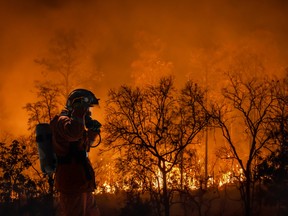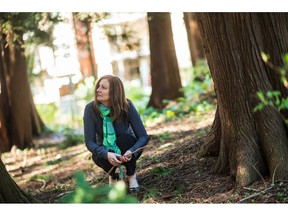Hearth ecologist Lori Daniels admits ‘coexistent’ appears counterintuitive however is critical with local weather change edging towards a warmer, drier future.

Article content material
The brand new centre for wildfire coexistence being established on the College of B.C. seems to have its work minimize out for it proper out of the gate.
As of Dec. 28, the B.C. Wildfire Service counted 106 wildfires from the file 2023 wildfire season as nonetheless burning. Most are throughout the Prince George fire-control area, which additionally stays in drought-stricken circumstances.
Commercial 2
Article content material
Article content material
“Zombie fires, we name them, after they go underground and smoulder by means of the winter,” stated Lori Daniels, UBC professor of forest and conservation sciences, who will lead the brand new centre. “But it surely’s stunning what number of (there are). I’ve had a number of studies from (analysis) collaborators about how a lot continues to be burning.”
The El Niño phenomena that has introduced hotter ocean temperatures is responsible, delivering hotter and drier climate throughout the west that has starved areas of their regular snow and chilly.
That implies the potential for these fires to roar again to life come spring, giving B.C. back-to-back seasons of maximum wildfire.
“Trying ahead, we’ve got plenty of group outreach and a few schooling plans,” Daniels stated in regards to the centre’s early work. “That’s one among our areas of experience.”
UBC’s school of forestry launched the centre Dec. 19 with $5 million in backing from UBC patrons, the Koerner household. Its activity is to take analysis findings about what makes communities weak to fireplace and translate these findings into making forests extra resilient.
“It’s type of counterintuitive,” Daniels stated in regards to the centre’s central premise of “coexistence” with fireplace, however “we’re dealing with a number of paradoxes about fireplace.”
Article content material
Commercial 3
Article content material

The primary being the long-held perspective of contemplating all forest fires “unhealthy, having unfavourable impacts,” when fireplace has at all times been a part of forest ecology, Daniels stated.
That perspective has solely lately shifted, however many years of wildfire suppression have left forests chock stuffed with understory brush that now serves as tinder for the large, extra intense forest fires B.C. has skilled in recent times, together with 2023 when 28,400 sq. kilometres — an space virtually the scale of Vancouver Island — burned.
Most foresters now have solely skilled essentially the most intense wildfires which have escaped suppression efforts and have tended to handle forests on that foundation, Daniels stated.
Meaning clearcut harvesting, then replanting in “early-succession” conifer timber that come again after large fires, which makes them extra prone to future high-intensity fires, particularly as local weather developments level to hotter and drier climate throughout a lot of B.C., Daniels stated.
“We want extra good fireplace again on the land,” which is the second paradox posed by the idea of coexistence, Daniels stated.
Commercial 4
Article content material
Meaning, when doable, having some prescribed fires in cool, moist years like 2022, emulating what Indigenous communities have carried out for millennia.
“After we look again over time, we see there was a number of floor fireplace” in forests, Daniels stated. “We will reconstruct that from tree rings and the scars (which are) embedded within the timber that survived.”
One other technique of Daniels’ new centre might be to collaborate with Indigenous communities, take the data of panorama from their oral histories, and mix that with western science to know how fireplace functioned up to now and the way it may be utilized in future forest administration.
“So there’s our coexistence,” Daniels stated.
That idea hit dwelling for Susan Melkey when the 2022 Briggs Creek wildfire, sparked by lightning, burned by means of a swath of the Kaslo and District Group Forest close to her dwelling.
“It was actually scary to see it come up the Monday after the lengthy weekend,” stated Melkey, who can also be a senior supervisor with the B.C. Group Forest Affiliation.
“All it takes is one storm to return by means of,” she added. And that fireside imposed large modifications on harvesting plans for the entire group forest.
Commercial 5
Article content material
“That’s why the ecosystem ought to have a requirement for resilience to wildfire,” Melkey stated. That could be a cause the group forest affiliation, which incorporates the Kaslo and District Group Forest, is collaborating with Daniels’ coexistence initiative.
Melkey stated the province has adopted some forward-thinking initiatives for decreasing wildfire danger in so-called wildland city interface areas and the provincial affiliation’s members have been enthusiastic subscribers.
“So we’re studying the right way to do it,” Melkey stated.
Daniels stated B.C. has created some glorious examples of wildfire mitigation.
The group of Logan Lake, southwest of Kamloops, for instance, defended itself efficiently from the large Tremont Creek wildfire in 2021 thanks partially to the adoption of fire-safe applications to clear potential fuels within the city interface.
“We have to scale it up,” Daniels stated, estimating that B.C. has spent most likely $500 million over the previous couple of many years.
Within the meantime, B.C. spent most likely $1 billion final yr and $4 billion over the past seven years to struggle forest fires
Commercial 6
Article content material
“We’re giving (mitigation applications) a whole lot of tens of millions of {dollars}, nevertheless it’s a billion-dollar downside.”
Daniels’ objective is to contribute some long-lasting options to the issue of wildfire danger, contemplating the way forward for a altering local weather.
“The trajectory we’re on clearly is one which has B.C. in excessive vulnerability,” she stated.
x.com/derrickpenner
Associated Tales
-

Not all doom and gloom: Listed here are 16 optimistic environmental tales from 2023
-

An enormous space of B.C. is at excessive fireplace danger. How will we shield it with out spending billions?
Bookmark our web site and assist our journalism: Don’t miss the information it’s essential know — add VancouverSun.com and TheProvince.com to your bookmarks and join our newsletters right here.
You may as well assist our journalism by changing into a digital subscriber: For simply $14 a month, you may get limitless entry to The Vancouver Solar, The Province, Nationwide Submit and 13 different Canadian information websites. Help us by subscribing at the moment:


